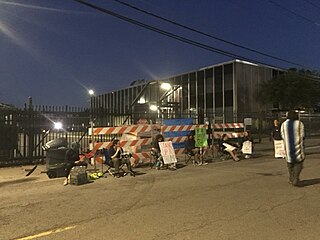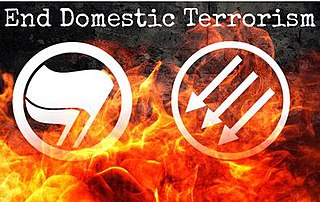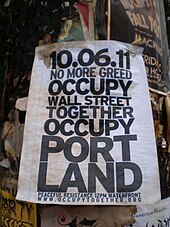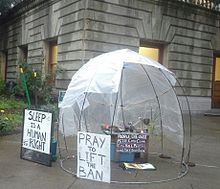
The history of the city of Portland, Oregon, began in 1843 when business partners William Overton and Asa Lovejoy filed to claim land on the west bank of the Willamette River in Oregon Country. In 1845 the name of Portland was chosen for this community by coin toss. February 8, 1851, the city was incorporated. Portland has continued to grow in size and population, with the 2010 Census showing 583,776 residents in the city.

The South Park Blocks form a city park in downtown Portland, Oregon. The Oregonian has called it Portland's "extended family room", as Pioneer Courthouse Square is known as Portland's "living room".

Edward Tevis Wheeler is an American politician who has served as the mayor of Portland, Oregon since 2017. He was Oregon State Treasurer from 2010 to 2016.

Occupy Boston was a collective of protesters that settled on September 30, 2011 in Boston, Massachusetts, on Dewey Square in the Financial District opposite the Federal Reserve Bank of Boston. It is related to the Occupy Wall Street movement that began in New York City on September 17, 2011.

The Occupy movement was an international populist socio-political movement that expressed opposition to social and economic inequality and to the perceived lack of real democracy around the world. It aimed primarily to advance social and economic justice and different forms of democracy. The movement has had many different scopes, since local groups often had different focuses, but its prime concerns included how large corporations control the world in a way that disproportionately benefits a minority, undermines democracy and causes instability.
Occupy Salem was a collaboration in Salem, Oregon based on the Occupy Wall Street movement which began in New York City on September 17, 2011. Occupy Salem has included peaceful protests and demonstrations.

Occupy Eugene was a collaboration that occurred in Eugene, Oregon based on the Occupy Wall Street movement which began in New York City on September 17, 2011. Occupy Eugene included peaceful protests and demonstrations. Protesters were concerned about inequities in the distribution of wealth, banking regulation, housing issues and corporate greed. The first protest march was held on October 15, 2011. The march started at the Wayne Morse Free Speech Plaza and continued downtown before marching over Ferry Street Bridge. It was reported that close to 2000 people were in attendance from all over the state of Oregon. Occupy Eugene continued to hold regular protests and actions until it left the encampment in December 2011. Protesters have stated that they do not have a set group of leaders. Occupy Eugene General Assemblies have met from as frequently as twice a day at times during active occupations, and as infrequently as weekly. Many committees have met since at least the third General Assembly, typically weekly. Decisions are made through a process known as consensus. Occupy Eugene's consensus process operates in a similar fashion to how consensus is being handled in New York City by protesters involved in Occupy Wall Street. Although the exact method varies from Occupation to Occupation. As of October 18, 2011, The Eugene police department was allowing protesters to camp in downtown Eugene, although city law prohibits it. Eugene police also stated that downtown camping won't be permanently allowed.

Occupy San Francisco was a collaboration that began with a demonstration event located at Justin Herman Plaza in the Embarcadero and in front of the Federal Reserve building on Market Street in the Financial District in San Francisco, California. It is based on the Occupy Wall Street movement that began in New York City on September 17, 2011 and is one of several "Occupy" protest sites in the San Francisco Bay Area; other sites include Occupy Oakland and Occupy San Jose.

The Occupy movement began in the United States initially with the Occupy Wall Street protests in New York City, but spread to many other cities, both in the United States and worldwide. This list article is an alphabetical, non-chronological summary of Occupy events that have occurred in cities in the United States.

The Plaza Blocks, two courthouse squares known as Chapman Square and Lownsdale Square, are located in downtown Portland, Oregon, United States. The blocks, as well as the adjacent Terry Schrunk Plaza, are surrounded by multiple government buildings including City Hall, the Green - Wyatt Federal Building, the Portland Building, the Multnomah County Justice Center, the Hatfield United States Courthouse, and the old Multnomah County Courthouse.

Cameron Whitten is an American community activist best known for advocacy on affordable housing, racial justice, and LGBT rights.

Right 2 Dream Too is a self-managed homeless encampment in Portland, Oregon incorporated as a nonprofit organization. The initial encampment was set up in October, 2011 on private property in Old Town Chinatown at Northwest 4th Avenue and West Burnside Street. The camp had permission from the property owner, but it was not authorized by the city. Right 2 Survive, the encampment's parent group and founder, organized an overnight shelter run by other homeless.

Thompson Elk Fountain, also known as the David P. Thompson Fountain, David P. Thompson Monument, Elk Fountain, the Thompson Elk, or simply Elk, was a historic fountain and bronze sculpture by American artist Roland Hinton Perry. The fountain with its statue was donated to the city of Portland, Oregon, United States, in 1900 for display in Downtown Portland's Plaza Blocks. It was owned by the City of Portland.

Fountain for Company H, also known as Second Oregon Company Volunteers, is a 1914 fountain and war memorial designed by John H. Beaver, installed in Portland, Oregon's Plaza Blocks, in the United States. Dedicated to the men of Company H of the 2nd Oregon Volunteer Infantry Regiment killed in service during the Spanish–American War, the limestone and bronze memorial was installed in Lownsdale Square in 1914. It is part of the City of Portland and Multnomah County Public Art Collection courtesy of the Regional Arts & Culture Council. The memorial has been included in published walking tours of Portland.

On November 10, 2016, three days of protests in Portland, Oregon, turned into a riot, when a group of anarchists broke off from a larger group of peaceful protesters who were opposed to the election of Donald Trump as president of the United States.

In 2016, a report from the Department of Housing and Urban Development (HUD) revealed that the U.S. state of Oregon had an estimated homeless population of 13,238 with about 60.5% of these people still unsheltered. In 2017, these numbers were even higher. As of January 2017, Oregon has an estimated 13,953 individuals experiencing homelessness. Of this homeless population, 1,083 are family households, 1,251 are veterans, 1,462 are unaccompanied young adults, and 3,387 are individuals experiencing chronic homelessness. As of 2022, 17,959 people total experienced homelessness in Oregon, with 2,157 individuals being youth under 18, 6,671 being female, 10,931 being male, and 131 being transgender. Also among the 17,959 total homeless in 2022, 15,876 were Non-Hispanic/Non-Latino, 2,083 were Hispanic/Latino, 13,960 were white, 1,172 were Black, African American, or African, 101 were Asian or Asian American, 880 were Native American, and those of multiple race were 1,619. Oregon has seen an increase in its total homeless population consistently every year since 2010. In last three years specifically Oregon has seen a 98.5% increase 2021-2022, 22.5% increase 2020-2021, and a 13.1% increase 2019-2020.

Occupy ICE is a series of protests, modeled on the Occupy Movement, that emerged in the United States in reaction to the Trump administration family separation policy, with a goal of disrupting operations at several U.S. Immigration and Customs Enforcement (ICE) locations.

The End Domestic Terrorism rally, sometimes subtitled "Better Dead Than Red", was a far-right demonstration organized by the Proud Boys and held in Portland, Oregon on August 17, 2019. The event, the purpose of which was to promote the idea that the "antifa" anti-fascist movement should be classified as "domestic terrorism", received national attention. The rally drew more counter-demonstrators than participants, with at least one group urging its members in advance not to attend, and ended with the Proud Boys requesting a police escort to leave.

Portland, Oregon has an extended history of street activism and has seen many notable protests.

Starting in May 2020, protests following the murder of George Floyd were held in the city of Portland, Oregon, concurrent with protests in other cities in the United States and around the world. By July 2020, many of the protests, which had been held every day since May 28, drew more than 1,000 participants. Protests continued into August, September, and October 2020, often drawing hundreds.


























